|
|
Paul Killiam’s “Sound Version”
|
|
For half a century, I have been banging my head against the wall trying
to figure out how Paul Killiam acquired a copy of The General.
It was in
1957, surely in response to The Buster Keaton Story,
that Paul managed that feat.
I have no proof at all, but I have eyes, I have the Landmark Laservision/Republic laserdisc,
and I have a computer on which I can watch the
file repeatedly.
Did Paul borrow a 35mm print from MoMA?
Paul convinced someone at MoMA to run off a new copy negative from the lavender, right?
Oh I was singing praises to myself, so proud that I had worked out a mystery that nobody else had ever worked out,
a mystery that nobody else even knew was a mystery.
I was floating on the clouds, so haughty about my genius instincts.
And I was wrong.
Totally, totally, totally, totally, totally wrong WRONG WRONG WRONG WRONG.
And wrong again.
That is not what happened at all.
|
|
Paul may have copied other stuff from MoMA,
but he did NOT copy The General from MoMA.
Absolutely impossible.
So where DID he copy it from?
|
|
Somehow he found someone at MGM to make a copy negative from the fine grain,
or he found someone at UA to run off a fine grain from the camera neg,
late at night when nobody was looking.
Or maybe he found someone willing to chance sneaking the masters out of the vault for a few hours
while Paul dashed off to a lab to make a new submaster.
It was something like that.
It was either MGM or UA, definitely.
Oh wait. Darn!
Why was I wondering?
He or someone he knew got access to the MGM fine grain.
It was definitely not the UA camera neg.
Why do I say that?
Because I just looked again at the video version of
The Great Chase,
which was in part printed directly from Paul’s master.
Though it is impossible to determine much about a film element by looking at a video,
I am nonetheless confident that it did NOT derive from a camera negative, but from something a generation removed from it.
|
|
How would anybody in 1957 have known about MGM’s fine grain?
Well, on the previous page, I surmised that it was Buster himself
who let Rudi Blesh and Ray Rohauer and Robert Smith and Sidney Sheldon
know that MGM had a vault print of The General.
If that’s what happened, then it probably came as a surprise to anyone at MGM that it was there.
Lo and behold, it was there, together with a fine grain.
If that’s what happened, then that’s how somebody at MGM knew.
The mystery is: Who tipped Paul off?
That mystery person arranged either for Paul to make a copy negative, or arranged for a copy negative to be made for Paul.
One or the other. No other possibility.
|
|
Could Paul have somehow gotten the fine grain through Ray Rohauer?
They had been business partners back in 1954 before becoming sworn enemies.
Remember, 1954 is when Ray acquired the bulk of his Buster collection,
but Ray did not get The General until January 1960, when he copied the preview print held by AMPAS.
Ray would not get access to the MGM fine grain until 1965 or maybe not until 1972.
|
|
It was not until July 1970 that anybody would have been able to notice
that Paul’s edition had a gap, a gap that exactly matched the damage
that the domestic camera negative had sustained by 1948.
But we don’t know that yet.
Nobody on the planet knew that yet — nobody except for Paul.
He had to hide that evidence, else he’d be found out.
We’ll get to that by and by.
|
|
Once Paul had a complete copy negative in hand,
he ran off a positive cutting copy and then set about abridging it.
He did more, besides.
He deleted all the opening and closing credits and replaced them with new Killiam credits,
and so any clues that those original credits would have provided are gone.
After his editor chopped half an hour out of the movie, he added sound.
This would be for a proposed TV series, you see.
|
|
The series was to be called
“Hour of Silents,”
a
|
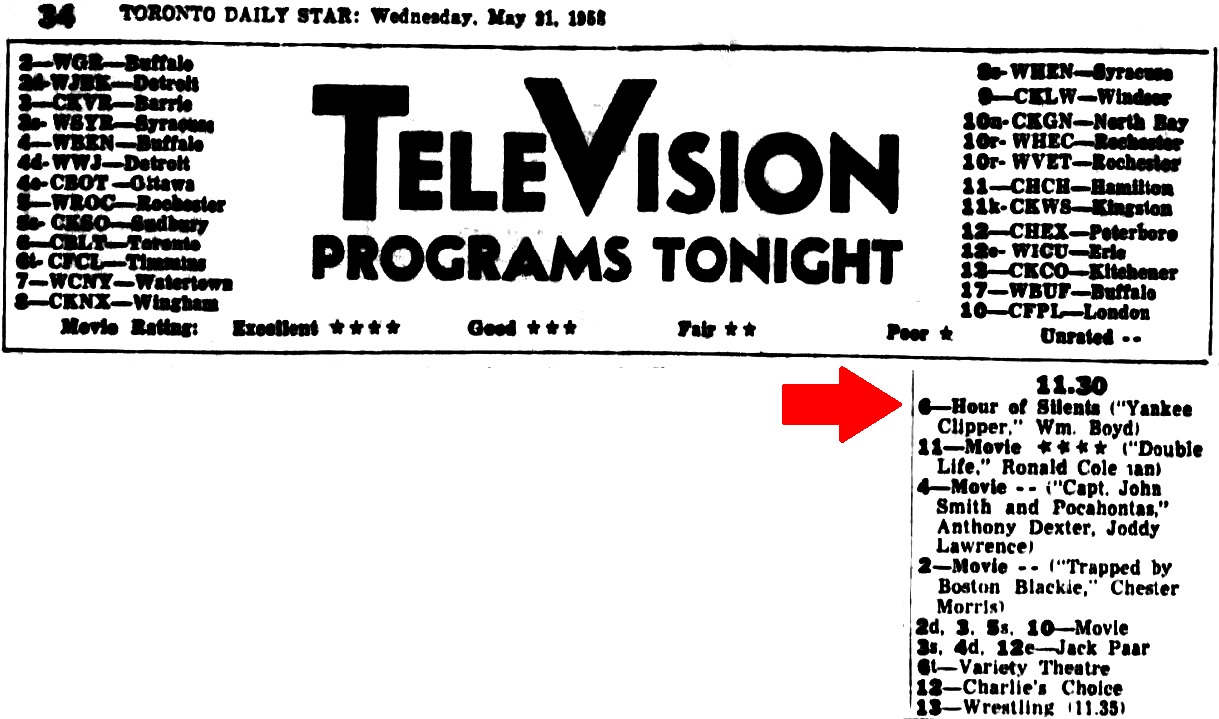 And that’s all I can find. Three episodes. Maybe there were more. If you can spot them, please let me know. Thanks! |
|
I just found a screen grab of the “Hour of Silents” edition on eBay,
and it predictably bears a 1957 copyright claim,
though I cannot find a registration anywhere:
|
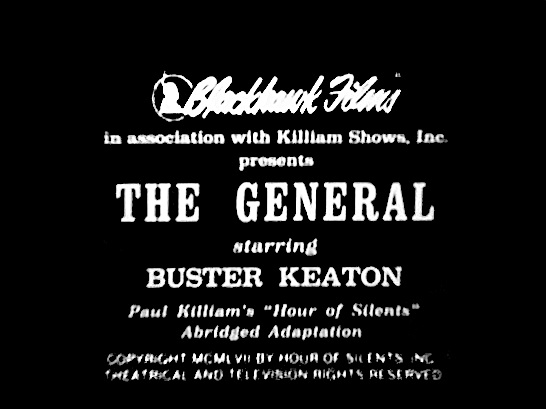
|
|
Now we should look at this, for Paul was able to sell his episodes to British television as well!
|
|
Notice something? A clue? A giveaway?
Look at the showtimes.
This “sound version” of The General began at 10:15pm and concluded at 11:05pm.
Fifty minutes.
Nearly a year later, another silent feature was shown on the BBC, The Yankee Clipper on
Sunday, 14 June 1959, originally
88 minutes but, predictably, it had a 50-minute time slot.
This broadcast was repeated on
Sunday, 13 September 1959.
Prior to this, in
1957, the BBC had broadcast Killiam’s
“Movie Museum” series.
All right, this is not fulsome research, but it is sufficient
to establish that the BBC had contracted with Killiam Shows for programming,
and that the BBC ran at least two episodes of “Hour of Silents.”
My guess is that when Paul failed to get his series broadcast,
he began selling it off one episode at a time to anyone he could,
in order to get at least some little return on his investment.
Paul did manage to sell his episodes to individual stations in the US.
Witness one recollection by a
George who seemed to be speaking of his youth in Texas:
“Plenty of titles followed by the early 1960s on TV,
including a series called Hour of Silents, which showed
|
|
We see here that Paul Killiam’s “Hour of Silents” version of The General
was also shown on WVIA Public Television Channel 44 in Scranton, Pennsylvania,
on Saturday, 26 October 1974.
How do we know that this is the “Hour of Silents” edition?
Because the article pulls quotes from Paul’s old press release,
which invented turns of phrase that by the 1970’s were being repeated everywhere
beyond the point of cliché.
|
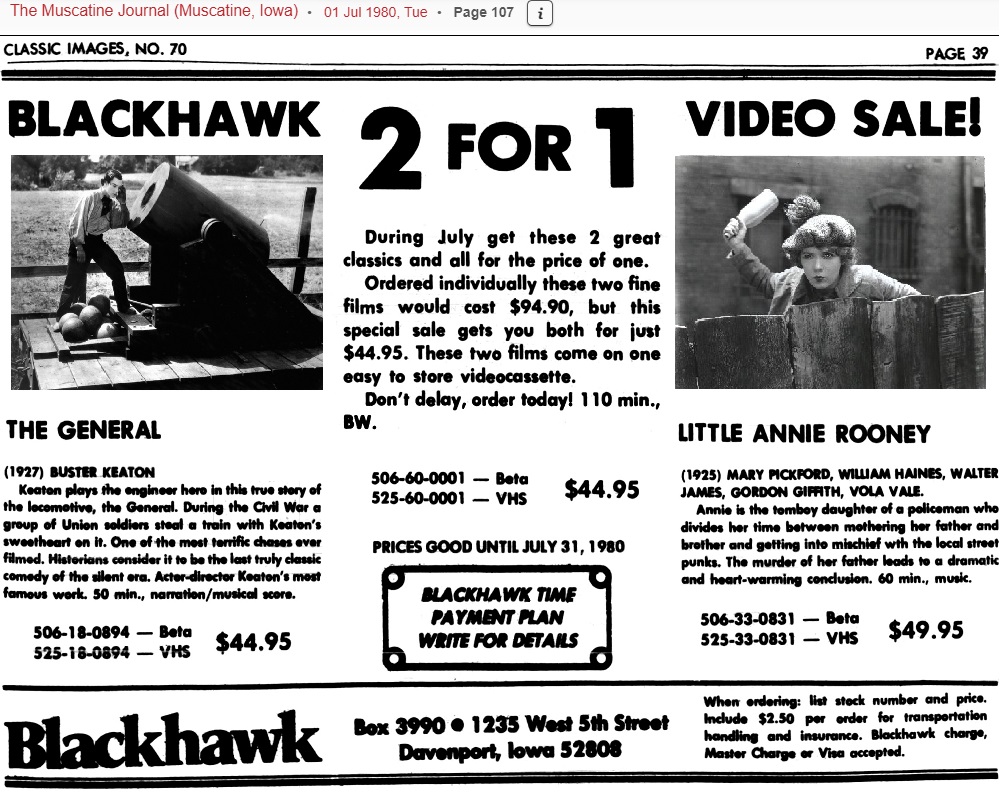 This was the first I ever heard about the “Hour of Silents” edition of The General having once been offered on home video. See also page 12. |
|
|
Paul Killiam’s narration is a disgrace.
The
The rest of the cues?
Prior to the days of the WorldWideWeb, investigating this would have taken decades rather than just two days.
The Retro 1950’s album was published by the successors to
Thomas J. Valentino, Inc.,
Production Music Library.
Now we’re getting somewhere.
When we Google “Playtime” and “Valentino” and “Music Library,”
we land on
this spreadsheet,
and there we discover, on page 133, that the composer was
Ernie Watson.
We need to crosscheck our work.
We go to YouTube and plug in “Ernie Watson” and “Playtime” and we hit the
• stroll (00:15)
• enlist (02:14) • rejected (06:12) • Kingston (11:04) • cannon (11:56) • flames (42:15) • rush (42:20) • flag (the beginning is traditional, but I can’t place it, 46:23)
That’s eight cues Shazam can’t identify.
No matter how many times I ask, Shazam just sheepishly shrugs its shoulders.
AHA Music isn’t helping either.
SoundHound is equally baffled.
The cannon thingamaroo sounds so similar to some pieces by
Roger Roger,
but I have no luck in locating it.
The bit at 46:23 with Johnnie filling in for the standard-bearer is from a symphony of some sort,
but we hear only a few notes before it crossfades to a musical effect, and musical effects, being only two or three seconds long, are almost impossible to identify.
So, I Googled to see who else could help, and Google said Google.
Google informs me that the call for volunteers
(03:09) and
Johnnie alerting the troops back in Marietta (40:07) are
Gustav Holst, “The Planets, Opus 32, Jupiter, the Bringer of Jollity” (1918).
That makes me feel superdumb.
I knew that music, but my mind had totally blanked and made the piece utterly unfamiliar.
Google also informs me that the scene of the Raid (08:16)
is Tchaikovsky’s “Francesca da Rimini,
Opus 32, Orchestral Fantasia after Dante” (1876).
Yup. Bingo.
Which particular recordings of these two pieces, heaven only knows.
The particular renditions of “Oh, Susanna,”
“Dixie,” and “Battle Hymn” are probably also from Valentino, but those will be harder to trace.
This was the wrong way to present The General,
the wrong way to edit it, the wrong way to create a soundtrack, the wrong way to choose a musical accompaniment.
This version of the movie is dead, flat, dull, dreary, repulsive.
I have no evidence, but I am certain that this edition drove thousands of potential admirers away forever.
Everything on screen was created by Buster, yes,
but it has all been so mangled, so ruined, so corrupted, that the result cannot be considered his by any argument.
This “Hour of Silents” edition of The General is a powerful demonstration
of a distributor’s poor editorial choices wrecking a film
and destroying a filmmaker’s reputation.
If you’re a glutton for punishment,
here it is. Beware.
|
|
This means nothing, but I put it here, just in case:
This “Hour of Silents” edition of the movie
was doubled with a MoMA print of The Gold Rush for the Tempe Film Society
at the Community Christian Church, 1700 El Camino Drive, on
Saturday, 17 September 1966.
It was shown at three libraries in the Tri-Cities region of Washington in
March through May 1975.
It then reappeared at the Mayne Williams Public Library in Johnson City, Tennessee, on
Thursday, 2 June 1977.
There were surely countless other such screenings,
and the very thought that people would have been subjected to this defamatory horror
pierces me to the marrow.
|
|
Some listings are confusing.
The version with sound effects shown on
Sunday, 25 May 1975, at the Dahl Fine Arts Center in Rapid City, South Dakota,
then on
Thursday, 18 November 1976, at the Central Library in Burbank, California,
and later on
Tuesday, 16 October 1979,
at the Eagle Rock Valley Historical Society, Eagle Rock City Hall, Los Ángeles, California,
was most likely Killiam’s “Hour of Silents” edition.
|
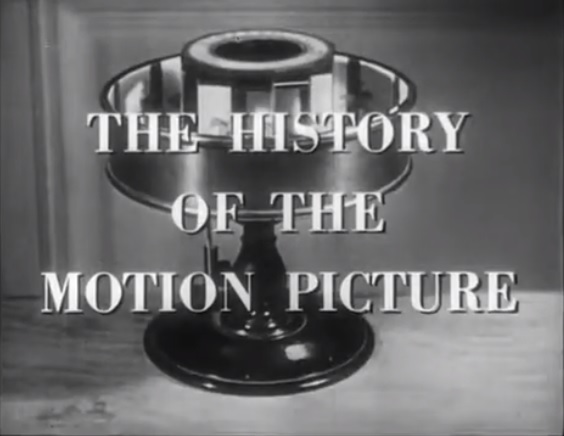
|
“The History of the Motion Picture”
|
|
Now we learn something astonishing.
The story behind this, I do not know.
Yet we do have some clues, and I shall transmit those clues to you.
If you have more clues, or more information, please share it.
Thanks!
|
|
Paul Killiam was a standup comic who had been one of Ray Rohauer’s business partners circa 1954.
They got along famously for about 12 minutes before they began suing one another.
Paul left Ray to continue running his recently founded circulating film collection, Killiam Shows.
|
|
Paul Killiam had created his “Hour of Silents” TV series in 1957 and got it onto a few airwaves in 1958.
The following year, he accomplished yet more, if ‘accomplish’ is the right word.
He hooked up with Saul Turrell’s Sterling Educational Films, Inc., to produce a series of films for classroom use.
This would be called “The History of the Motion Picture,”
which consisted largely of condensations, as before, but more severe.
Rather than running 49 minutes, these would run a mere 25 minutes.
The editor who performed these amputations was, as far as I know, William C. Dalzell.
Whether he had been responsible for the earlier “Hour of Silents” I do not know.
He went straight back to the master copy negatives and cut them, physically,
and he is the one who, as far as I know, compiled the music scores from library recordings.
Which library, I do not know.
I asked Shazam to identify each cue, but Shazam came up with the same response each time:
“No Result.”
If you can identify any of these music cues, don’t keep it a secret. Thanks!
|
|
The intro was narrated by Paul himself, but for the remaining stump of the film,
the great Frank Gallop took over the honors.
|
|
On eBay I chanced upon a 16mm print of this episode of “The History of the Motion Picture”
and I snapped it up right away, for a hundred buckaroos.
It arrived, in its original can and with its original labels, no less!
I see that it was distributed by
Sterling Educational Film, “Produced and Written by PAUL KILLIAM and SAUL J. TURRELL,”
with a 1959 copyright notice in the name of
Gregstan Enterprises, Inc.
The bottom parenthetical line: “(Not to be exhibited on Television).”
I do not know how to read the Ferrania edge code:
•••■
Alas, I no longer have a projector, and so the can is just sitting here in my apartment.
|
|
I had searched and searched and searched for an online copy of this episode.
Though I found a bunch of episodes of “The History of the Motion Picture,”
I could never find the episode dealing with The General.
I searched under “Killiam” and I searched under “Sterling Educational” and I searched under “Sterling Films”
and I searched under “Silents Please” and I searched under “History of the Motion Picture”
but there was nothing nothing nothing nothing nothing.
Then, just now, when I searched simply under “Keaton The General” I got a hit!
Here it is, a battered copy, very choppy, missing a total of about three minutes:
|
|
Here is the 25-minute abridgment of The General included in
“The History of the Motion Picture.”
The quality of the print and the quality of the transfer are dreadful. Sorry.
|
|
|
|
Public Domain Movies,
Buster Keaton - The General (1926)
https://youtu.be/lbzorV_jEW8 also available at https://archive.org/details/thegeneral_201512 and at https://youtu.be/xtaQ_L9oEOc. When YouTube disappears this video, download it. |
|
What a mess!
The abridgment ruins the film, the needless narration ruins it even more, and the music ruins it yet even more.
Whoever made this film-to-video transfer for YouTube mistakenly turned on the cheap motion stabilizer,
and cheap motion stabilizers really don’t do the world any good.
|
|
Below is a list of 30 of the episodes.
There were definitely more than that.
|
| CLASSROOM SERIES | ||||
| Number 04 | 1958 | The Fun Factory | LP0000046291, RE0000406582 | |
| Number 06 | 1958 | Buster Keaton | ||
| Number 14 | 1959 | The General | LP0000043989, RE0000406575 | |
| Number ?? | 1959? | The Son of the Sheik | PA0000415055, RE0000425328 | |
| Number ?? | 1959? | America’s Greatest Cowboy! William S. Hart | LP0000046292, RE0000406583 | |
| Number ?? | 1959? | Tempest | PA0000415052, RE0000425336 | |
| Number ?? | 1959? | Orphans of the Storm, Part One | PA0000415049, RE0000425333 | |
| Number ?? | 1959? | Orphans of the Storm, Part Two | PA0000415040, RE0000425342 | |
| Number ?? | 1959? | The Black Pirate | LP0000043994, RE0000406577 | |
| Number ?? | 1959? | The Eagle (fragment) | PA0000415048, RE0000425332 | |
| Number ?? | 1959? | The Hunchback of Notre Dame | ||
| Number ?? | 1959? | America | PA0000415051, RE0000425335 | |
| Number ?? | 1959? | The Thief of Bagdad | ||
| Number ?? | 1959? | The Sad Clowns | ||
| Number ?? | 1959? | Variety | ||
| Number ?? | 1959? | Girls in Danger | LP0000046293, RE0000406584 | |
| Number ?? | 1959? | The Garden of Eden | ||
| Number ?? | 1959? | The Road to Yesterday | PA0000415045, RE0000425337 | |
| Number ?? | 1959? | Dracula [Nosferatu] | LP39034 | |
| Number ?? | 1959? | The Fall of Babylon | LP59035 | |
| Number 33 | 1959? | Will Rogers | LP0000046287, RE0000406578 | |
| Number ?? | 1959 | Dr. Jekyll and Mr. Hyde | LP39033 | |
| Number ?? | 1959 | The Yankee Clipper | PA0000415039, RE0000425341 | |
| Number ?? | 1959 | The Story of the Serials | ||
| Number ?? | 1959? | The Three Musketeers, Part One | ||
| Number ?? | 1959? | The Three Musketeers, Part Two | ||
| Number ?? | 1959? | Film Firsts, Part One | LP0000046288, RE0000406579 | |
| Number ?? | 1959? | Film Firsts, Part Two | LP0000046289, RE0000406580 | |
| Number ?? | 1959? | When the Clouds Roll By (audio only) | ||
| Number ?? | 1959? | The Clown Princes of Hollywood | ||
The World’s First
|
|
Charlie Chaplin had just gone to Europe and the US immigration authorities wanted to give him a difficult time about returning.
So he decided not to return.
He had his wife Oona arrange to have outtakes and trims and spares destroyed.
The footage, which filled a truck, was driven over to the American Recovery Company,
but the place was locked and sealed after a recent bankruptcy.
Pending a contract with a different firm, the film materials were put into storage,
and one of the storage employees knew to contact Ray, who immediately purchased the entire lot.
Inside were countless outtakes of numerous Chaplin films,
including The Gold Rush, which had not been seen in its original form since the early 1930’s.
Ray, together with Erwin Dumbrille, pieced The Gold Rush back together.
For many scenes, they had Chaplin’s cutting copy with the corresponding negatives or copy negatives or lavenders,
and those sections of the film exactly matched the original.
As for the rest, they just guessed.
Since the copyright to the 1925 edition expired in January 1954,
and since Chaplin’s staff had neglected to renew it,
Ray decided that he would issue his new edition.
He lopped off the left side of the image to make way for an organ accompaniment (probably by John Muri,
but I’m really not sure about that), and he contracted with Robert B. “Bob” Fischer’s small firm,
Artistic Films, Inc., to put the movie into limited release.
When Chaplin learned about this, he blew his top and fought for years to put a stop to this unauthorized edition.
That, though, is a whole other story, which we shall explore a little later on.
In the meantime, Ray doubled his release of the unauthorized Gold Rush
with a touring Buster Keaton Festival, with Buster himself traveling from city to city as the guest of honor.
This was scheduled and booked, but it never happened.
Why not?
My guess is that Loew’s and MGM and Leopold Friedman probably filed an injunction.
That’s my guess.
|
Cinema Theater (formerly Lyric),
|
|
This was a 35mm print.
In the US at the time, there were no 35mm prints of The General for rental.
Where on earth did that print come from?
My guess is that it was an unclaimed leftover from a disused UA exchange.
If my guess is correct, then Earl likely traded for it with another collector.
Was this perchance the tinted 1926 original that David Shepard found more than thirty years later?
Unlike many nitrate prints, the print that David discovered seemed still to be in good, projectable condition,
or, at least, parts of it so seemed,
and that is how he managed to run it through a scanner.
I so wish we had more information about the print that Earl showed from 16–18 June 1960.
This here Earl Noah “Buck” Manbeck, Junior
(8 Nov 1921 – 20 Jan 2007),
feller was an odd one, eccentric, Iowa’s iteration of Jim Card.
See
“Earl N. Manbeck Finds Movie Hobby Is Fun,”
Boxoffice vol. 62 no. 13, Saturday, 24 January 1953, p. 73;
“Des Moines — Earl Manbeck, local exhibitor,” Exhibitor vol. 50 no. 5, sec. 1, 3 June 1953,
|
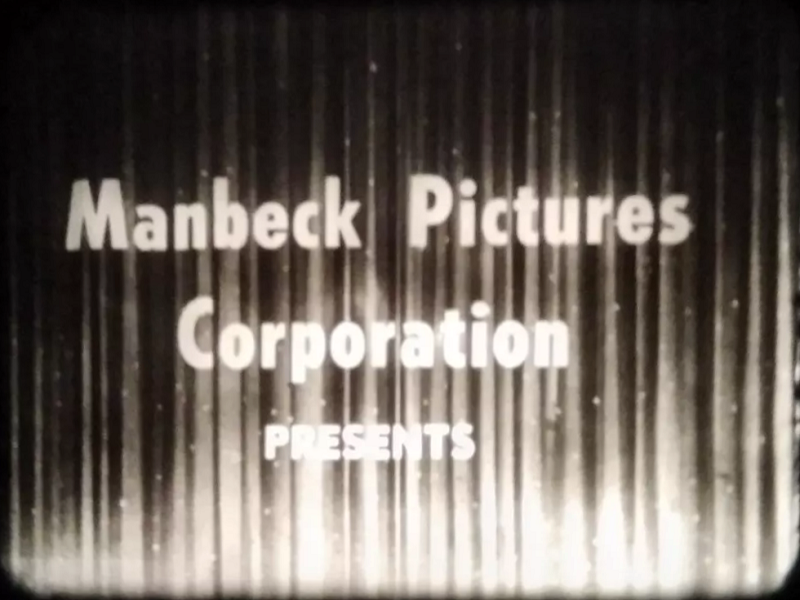
|
|
Zo apparently this Manbeck feller distributed 16mm silents.
|
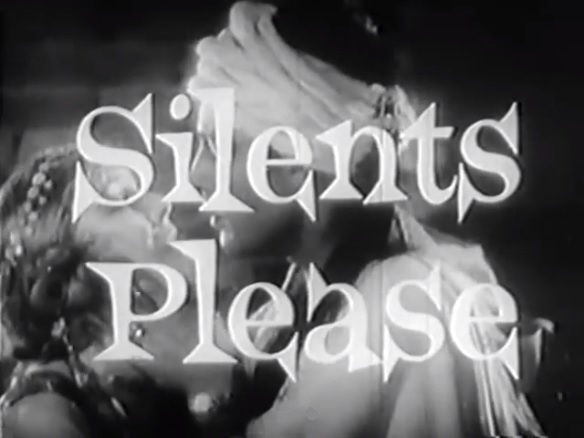
|
Silents Please |
|
Paul failed to get his “Hour of Silents” series onto a US network,
but he did get his series of 25-minute abridgments into classrooms.
Could he merge the two ideas?
Yes!
He proposed a new TV series,
Silents Please, which was merely “The History of the Motion Picture”
but with different opening and closing credits.
He found a sponsor, perhaps several sponsors, and went to town.
Each 25-minute abridgment in the series was narrated, sometimes by Paul himself and sometimes by the great Frank Gallop.
The show premièred on Thursday, 4 August 1960,
and the second episode, Thursday, 11 August 1960, was the condensation of The General.
|
|
Though I have seen a Super 8 silent print of the 25-minute version of The General, and
though I have now finally seen the episode of “The History of the Motion Picture,”
yet I have never seen the “Silents Please” TV episode.
Should it ever turn up, it will probably contain a surprise or two.
It is most interesting that
the closing credits to at least one of the episodes name
as consultants Theodore Kupferman and Richard Griffith, curators of the Museum of Modern Art Film Library.
Did those two consultants recognize where some of Paul’s prints came from?
Altogether, these uploads indicate that all the materials likely still exist somewhere.
|
|
It is doubtful that Buster watched this episode of the TV show,
though he certainly learned about it soon afterwards.
He was not happy about it, as we shall see below.
|
|
Out of curiosity, I decided to trace “Silents Please” —
well, as best as the fragmentary newspaper listings allow.
As you see, some of these episodes are online,
some of them in English and some of them in Spanish,
one of them only a momentary fragment,
one of them
|
| ABC NETWORK, FIRST SERIES | |||
| SPOKEN INTRODUCTIONS BY PAUL KILLIAM | |||
| Ser 1 Ep 01 | Thu 04 Aug 1960 | The Son of the Sheik (Spanish) | PA0000415055, RE0000425328 |
| Ser 1 Ep 02 | Thu 11 Aug 1960 | The General | LP0000043989, RE0000406575 |
| Ser 1 Ep 03 | Thu 18 Aug 1960 | Dr. Jekyll and Mr. Hyde (Spanish) | LP39033 |
| Ser 1 Ep 04 | Thu 25 Aug 1960 | The Yankee Clipper | PA0000415039, RE0000425341 |
| Ser 1 Ep 05 | Thu 01 Sep 1960 | America’s Greatest Cowboy! William S. Hart | LP0000046292, RE0000406583 |
| Ser 1 Ep 06 | Thu 08 Sep 1960 | The Fun Factory | LP0000046291, RE0000406582 |
| Ser 1 Ep 07 | Thu 15 Sep 1960 | Tempest (Spanish) | PA0000415052, RE0000425336 |
| Ser 1 Ep 08 | Thu 22 Sep 1960 | The Story of the Serials | |
| Ser 1 Ep 09 | Thu 29 Sep 1960 | Orphans of the Storm, Part One | PA0000415049, RE0000425333 |
| Ser 1 Ep 10 | Thu 06 Oct 1960 | Orphans of the Storm, Part Two | PA0000415040, RE0000425342 |
|
Upon the broadcast of the tenth episode on 6 October 1960, ABC canceled the series.
|
|
ABC renewed the license and brought the series back in January 1961,
now hosted by
Ernie Kovacs, who, alas, never recorded an introduction for The General.
|
| ABC NETWORK, SECOND SERIES | |||
| FILMED INTRODUCTIONS BY ERNIE KOVACS | |||
| Ser 2 Ep 01 | Thu 23 Mar 1961 | The Black Pirate | LP0000043994, RE0000406577 |
| Ser 2 Ep 02 | Thu 30 Mar 1961 | The Eagle (fragment) | PA0000415048, RE0000425332 |
| Ser 2 Ep 03 | Thu 06 Apr 1961 | The Hunchback of Notre Dame | |
| Ser 2 Ep 04 | Thu 13 Apr 1961 | Will Rogers | LP0000046287, RE0000406578 |
| Ser 2 Ep 05 | Thu 04 May 1961 | America | PA0000415051, RE0000425335 |
| Ser 2 Ep 06 | Thu 11 May 1961 | The Thief of Bagdad | |
| Ser 2 Ep 07 | Thu 25 May 1961 | The Sad Clowns | |
| Ser 2 Ep 08 | Thu 01 Jun 1961 | Variety (Spanish) | |
| Ser 2 Ep 09 | Thu 08 Jun 1961 | Girls in Danger | LP0000046293, RE0000406584 |
| ABC NETWORK, THIRD SERIES | |||
| FILMED INTRODUCTIONS BY ERNIE KOVACS | |||
| Ser 3 Ep 01 | Thu 07 Sep 1961 | The Garden of Eden | |
| Ser 3 Ep 02 | Thu 14 Sep 1961 | The Road to Yesterday | PA0000415045, RE0000425337 |
| Ser 3 Ep 03 | Thu 28 Sep 1961 | Dracula [Nosferatu] (Spanish) | LP39034 |
| Ser 3 Ep 04 | Thu 05 Oct 1961 | The Fall of Babylon | LP59035 |
|
ABC once again canceled the show.
Kovacs died in a car wreck on Saturday, 13 January 1962, and that spelled the end of the series,
as far as the network was concerned.
|
|
Saul Turrell and Paul Killiam then put the old episodes into syndication
and continued recycling episodes of “The History of the Motion Picture” for the TV series,
presumably with Gloria Swanson offering brief intros.
|
|
|
|
Cinecinéfilos films,
Gloria Swanson presenta
“El maquinista de la general” (“The General”) Dec 14, 2019 When YouTube disappears this video, download it. (The truth? Gloria Swanson privately admitted that she had no sense of humor and disliked comedies.) |
|
Gloria offered the above intro to rebroadcasts of the 25-minute edition of The General,
and, as far as I can tell, her intro appeared only five times:
|
|
Saturday, 18 May 1963, Sacramento, KCRA Channel 3
Saturday, 8 June 1963, Los Ángeles, KCOP Channel 13 Saturday, 13 July 1963, San José, KNTV Channel 11 Thursday, 8 June 1972, San Francisco, KPIX Channel 5 Saturday, 30 December 1972, Detroit, WWJ Channel 4 |
| The above episodes then all went into syndication, together with NEW EPISODES FOR THE SYNDICATED SERIES | ||||
| KCOP 13 LÁ | Synd Ep 01 | Mon 16 Jul 1962 | Blood and Sand | L18230 |
| KCOP 13 LÁ | Synd Ep 02 | Mon 13 Aug 1962 | The Three Musketeers, Part One | |
| KCOP 13 LÁ | Synd Ep 03 | Mon 20 Aug 1962 | The Three Musketeers, Part Two | |
| WPIX 11 NYC | Synd Ep 04 | Wed 19 Sep 1962 | Lilac Time | PA0000415046, RE0000425338 |
| KIRO 7 Seattle | Synd Ep 05 | Sat 24 Nov 1962 | The Americano | |
| WPIX 11 NYC | Synd Ep 06 | Wed 26 Dec 1962 | Don Juan, Part One | |
| WPIX 11 NYC | Synd Ep 07 | Wed 02 Jan 1963 | Don Juan, Part Two | PA0000415042, RE0000425339 |
| WLWD 2 Dayton | Synd Ep 08 | Wed 13 Feb 1963 | Old San Francisco | PA0000415047, RE0000425331 |
| KPIX 5 SF | Synd Ep 09 | Sat 06 Apr 1963 | Film Firsts, Part One | LP0000046288, RE0000406579 |
| WPIX 11 NYC | Synd Ep 10 | Sat 13 Apr 1963 | Film Firsts, Part Two | LP0000046289, RE0000406580 |
| WPIX 11 NYC | Synd Ep 11 | Wed 22 May 1963 | ||
| KNTV 11 San José | Synd Ep 12 | Sat 23 May 1963 | The Patent Leather Kid | PA0000415041, RE0000425343 |
| KCRA 3 Sacramento | Synd Ep 13 | Sat 01 Jun 1963 | Slapstick (no image; Spanish audio only) | LP0000043991, RE0000406576 |
| KCOP 13 LÁ | Synd Ep 14 | Thu 06 Jun 1963 | Rin-Tin-Tin [Tracked by the Police] | PA0000415058, RE0000425322 |
| KLFY 10 Lafayette | Synd Ep 15 | Thu 15 Aug 1963 | Hoodoo Ann | PA0000415038, RE0000425340 |
| KNTV 11 San José | Synd Ep 16 | Sat 17 Aug 1963 | The Clown Princes of Hollywood | |
| WLWD 2 Dayton | Synd Ep 17 | Wed 30 Oct 1963 | The Headless Horseman | |
| ABV 2 Melbourne VIC | Synd Ep 18 | Sat 25 Apr 1964 | The Sea Beast | PA0000415057, RE0000425329 |
|
This series was once offered on VHS, which I find surprising.
I had never seen it on offer anywhere.
Here is an amusing recollection posted on
IMDb.
This note got one thing backwards, understandably.
“The History of the Motion Picture” came before “Silents Please.”
Anyway, enjoy:
|
|
Many of the “Silents, Please” episodes turned up — sans Kovacs —
retitled as “The History of the Motion Picture” and were made available to public libraries in the 1960s.
All footage was public domain.
They were released on VHS in 1997 from Critics’ Choice Video in transfers made from old ragtag prints,
some with
|
|
I guess that most of what we find online was just uploaded from those commercial VHS tapes.
And I suppose the VHS tapes were sourced from school-library discards.
|
The UK Film-Society Prints |
|
We learn that The General
was a popular rental item to British film societies,
but who was the distributor?
I asked around.
The BFI was clueless.
This required yet more research.
The 16mm market in the UK was pretty much cornered by two firms.
The first was
Plato Films, Ltd. (247a Upper Street, London N1 1RU), founded by
Stanley
Forman in 1950.
For legal reasons, this became
ETV (Education and Television Films).
I have not seen a catalogue, but I understand that Plato’s concentration was on Communist films, not entertainment.
A second company, founded the following year, took care of the market for entertainment films.
It was called
Contemporary Films, Ltd. (8 Dickenson Road, London N8 9EN), founded by Charles Cooper in 1951.
The current executive at Contemporary is quite sure that The General
was never in his company’s catalogue.
Contemporary put me in touch with a researcher who suggested some other possibilities:
Gala Film Distributors, Ltd. (30 Tottenham Court Road, London W1), and
Connoisseur Films, Ltd. (167 Oxford Street, London W1,
|
|
Oh heavens to Betsy!
I found the distributor!
The BFI!!!!!
The BFI is apparently divided into two departments: archive and distribution.
The staffs of the two divisions seem never to meet, never to socialize,
and never even to bump into each other in the lunch room or in the corridors.
They probably use opposite entrances to get into the building,
and it actually seems that each department is unaware of the other’s existence.
The BFI seems not to have had The General available for distribution in
early 1955, though, as we witnessed, the Archive’s 16mm print made the rounds to a few film clubs.
The Distribution arm’s print of the film was certainly available for by
September 1961 (see also
this)!
Actually, considering that it made the cover that month, that was surely when it was introduced into the catalogue.
Prints were available in 35mm, 16mm, 9.5mm, and 8mm.
Now, from whence did the BFI acquire this film for rental?
The BFI circulation department has zero interest in responding to my enquiries, and so I am left again to guesswork.
My guess is that the BFI ordered a lavender from the UA London office.
An alternative guess, at least as likely, is that the BFI ordered a copy negative from MoMA.
It seems that these circulating prints and their master have vanished from the face of the earth.
If you can locate any of these materials, even a single frame, please let me know. Thanks!
What is the true story, and what is the reason for that true story?
The truth will be revealed nel suo tempo.
|
Cobwebby Features |
|
All parties are anonymous in this bizarre story from the weekly Variety.
Someone claimed to have been offering The General for distribution to US cinemas.
Who?
Was it Rohauer who was offering this?
He had a dupe negative that he needed to amortize, and the film was by now in the public domain in the US.
The only commercial entities with 35mm materials were MGM and Raymond Rohauer,
and so my guess is that this was either MGM or Rohauer.
Since MGM seemed pretty much unaware of its possession of a lavender,
my best guess is that this was Rohauer.
Or, ya know, maybe not.
Could this have been Paul Killiam offering his 49-minute “Hour of Silents” edition?
If so, that would explain why no distributor placed a bid.
I bet it was Killiam. I bet it was Killiam. I bet.
|
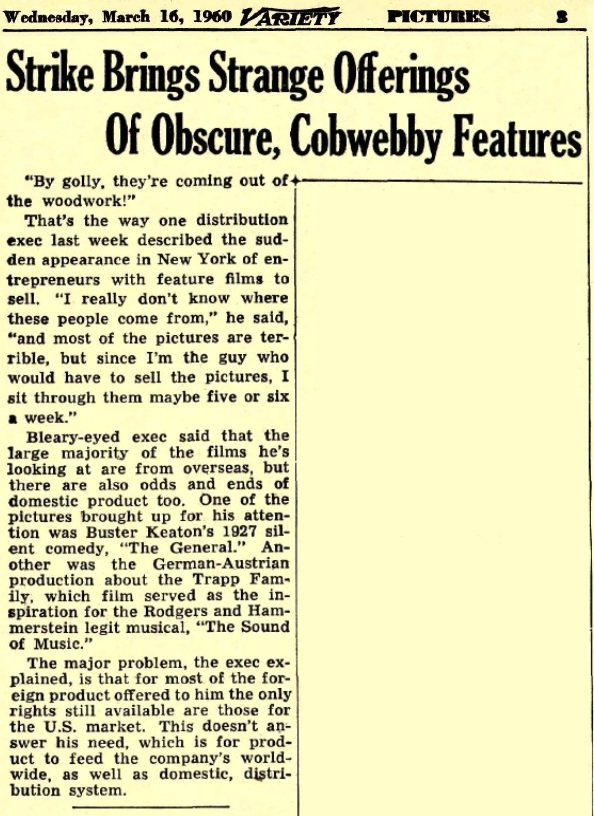
|